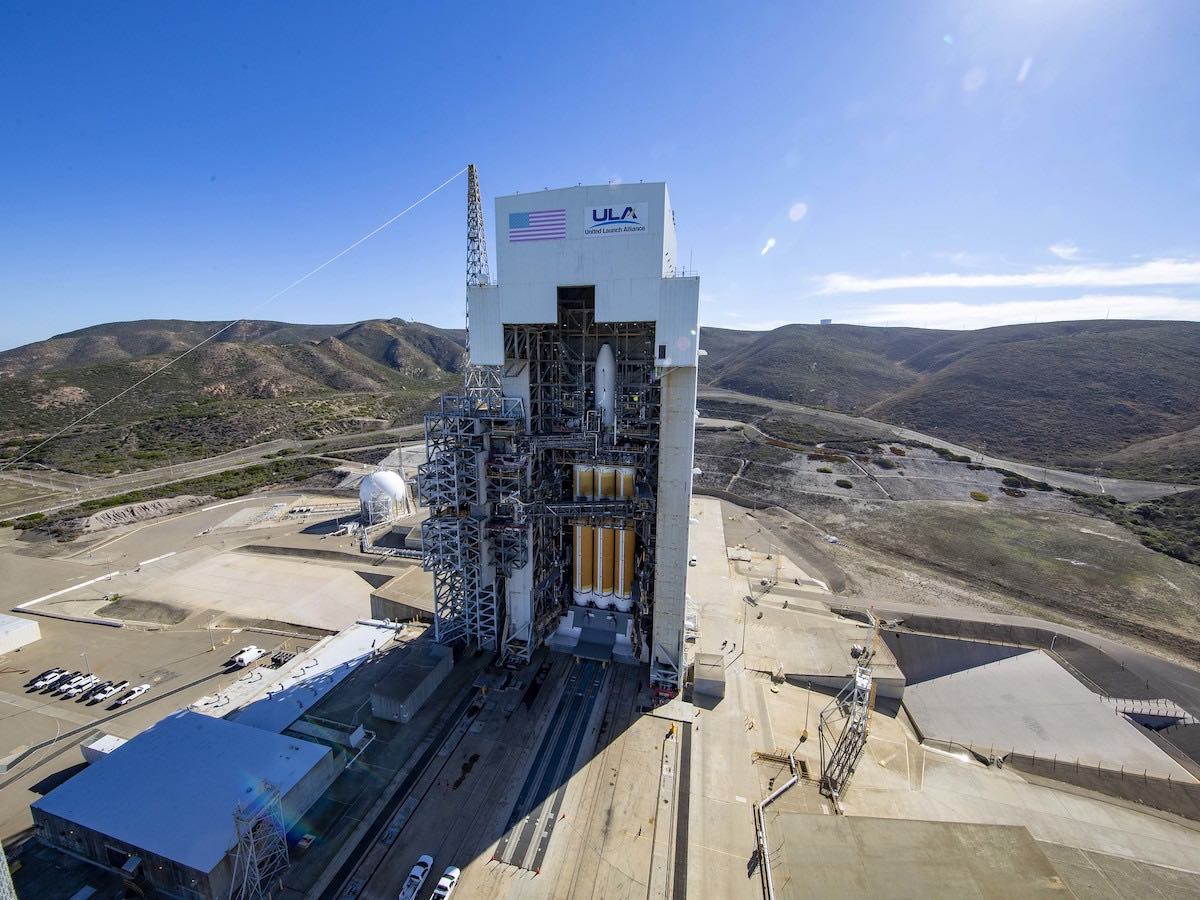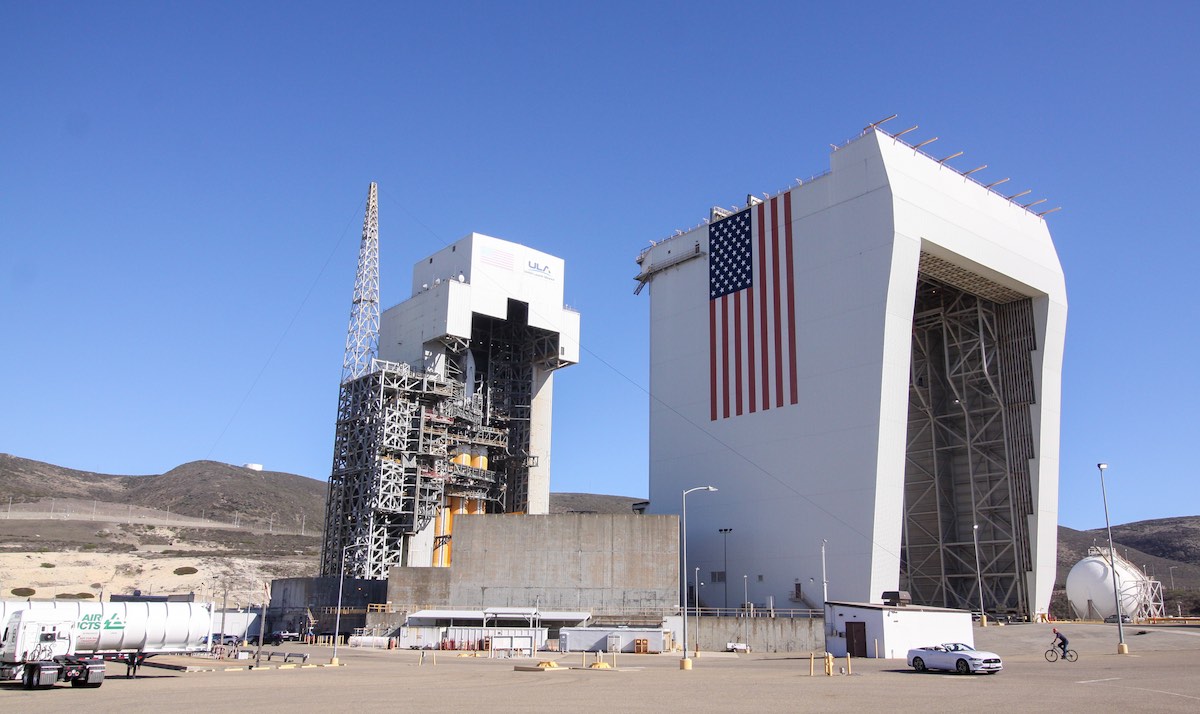
United Launch Alliance will move out of historic Space Launch Complex 6 at Vandenberg Space Force Base in California following the flight of a Delta 4-Heavy rocket set for Saturday, leaving the military to find a new tenant for the launch pad once intended to host space shuttle missions on the West Coast.
The Delta 4-Heavy rocket is scheduled to blast off at 2:53 p.m. PDT (5:53 p.m. EDT; 2153 GMT) Saturday from the SLC-6 launch site, nestled on a remote hillside overlooking the Pacific Ocean near the southwestern edge of Vandenberg Space Force Base, roughly 140 miles (225 kilometers) northwest of Los Angeles.
“The hardware is ready to fly,” said Gary Wentz, ULA’s vice president of government and commercial programs. “We’re in great condition. We’re not working any issues for Saturday’s launch. We’re on track for for an afternoon launch with no open issues or activities that we have to work.”
The payload on the rocket is a classified spy satellite for the National Reconnaissance Office, which owns the U.S. government’s fleet of reconnaissance and intelligence-gathering spacecraft.
“We like to say we’re the nation’s eyes and ears in space,” said Space Force Col. Chad Davis, director of the NRO’s Office of Space Launch. “So we provide that capability for our warfighters, allied and U.S., for our national decision makers to put them in the best spot they possibly can to either make decisions or execute what they need to on the battlefield.”
The launch Saturday is known as NROL-91, and will be the final flight of ULA’s powerful Delta 4-Heavy rocket from California. It’s also the 95th and final Delta rocket overall to launch from Vandenberg. ULA is retiring the Delta 4 rocket family in favor of the next-generation Vulcan Centaur launcher, which will exceed the Delta 4-Heavy’s payload lift capability and ULA says will be cheaper to build and operate.
“For us, seeing the last Delta launch from Vandenberg is bittersweet, for sure. We’re sorry to see it go,” said Col. Bryan Titus, vice commander of Space Launch Delta 30, the unit in charge of Vandenberg Space Force Base and the Western Range.
There are two more Delta 4-Heavy rockets left to launch from Cape Canaveral in early 2023 and 2024 before the Delta rocket family is retired for good. Both of those missions will also launch classified payloads for the NRO. The NROL-91 mission will mark the 387th flight of a Delta rocket overall, the 43rd Delta 4, and the 14th in the Delta 4-Heavy configuration, created by combining three expendable hydrogen-fueled booster cores together to haul the military and NRO’s most massive payloads into orbit.
The Delta 4-Heavy stands 233 feet (71 meters) tall and will generate 2.1 million pounds of thrust at liftoff with its three Aerojet Rocketdyne RS-68A main engines. The rocket can deliver payloads up to 62,540 pounds (28.3 metric tons) to low Earth orbit, making the Delta 4-Heavy one of the most powerful operational launchers in the world.
“The National Reconnaissance Office puts absolutely exquisite capabilities on orbit,” Davis said. “And the natural extension to that is the Delta 4-Heavy is used for some of those even most exquisite and most sensitive kinds of capabilities that I wish we could share with the broader community. But that’s part of the idea, is that people don’t know that we can do the kinds of things that we can do in space, and that vehicle is just part and parcel to those absolutely exquisite capabilities on orbit delivering for this nation.”
After retirement of the Delta 4-Heavy, the NRO’s heaviest payloads will launch on SpaceX’s Falcon Heavy rocket or ULA’s Vulcan. Both are less expensive than the Delta 4-Heavy, which is priced at more than $400 million per mission.
For Saturday’s mission, the Delta 4 team will work through a nearly 10-hour countdown leading up to liftoff. Asked what to expect Saturday, Davis said: “You just never know. Launch is hard. You’ve got 10 million parts working together in concert simultaneously, perfectly, and then you can launch.”
There’s a 90% chance of acceptable weather for Saturday afternoon’s launch window.
“The weather’s looking really good right now,” Davis said. “The booster is looking really clean right now. The spacecraft is fully configured and ready for launch. So what we’re really hoping for, and the way that it’s looking like it may play out, is all those things fall in place. The majority of the launch team will get on console about 4 a.m. souped up on coffee. We’ll configure the booster. The spacecraft team will get the spacecraft ready to go. We’ll put the cryogenic fuel and oxygen into the into the launch vehicle and then mid-afternoon, we’ll see a fantastic looking candle in the sky.”

The top secret spy satellite on top of the Delta 4-Heavy rocket is likely a new sharp-eyed electro-optical Keyhole-type imaging platform for the NRO, according to independent analysts. But the NRO has not disclosed details of the satellite, keeping with the spy agency’s policy of not commenting on details of its missions.
Maritime exclusion zones published as part of public navigation warnings suggest the Delta 4-Heavy on the NROL-91 mission will fly south-southeast from Vandenberg over the Pacific Ocean. Based on publicly available data, analysts estimate the mission will aim to place its classified cargo into low Earth orbit at an latitude of around 250 miles (400 kilometers) and an inclination of approximately 74 degrees to the equator.
Those parameters closely match a previous Delta 4-Heavy rocket launch for the NRO in January 2019, designated NROL-71.
The Delta 4-Heavy is the most powerful rocket in ULA’s current fleet, and the largest rocket to ever launch from California. The Delta 4-Heavy’s main engines will power the launcher faster than the speed of sound in 81 seconds as it soars downrange over the Pacific Ocean.
The core stage engine will throttle down its RS-68A engine to a partial thrust setting, conserving its supply of liquid hydrogen and liquid oxygen propellants while the side boosters fire at full throttle. The side boosters will shut down their RS-68A engines and jettison about four minutes into the mission, falling to predetermined drop zones in the Pacific. The core stage will burn until around about five-and-a-half minutes into the flight, then jettison to yield to the Delta 4’s hydrogen-fueled upper stage.
The upper stage will fire its RL10 engine moments later, and the rocket will release its nose fairing into a clamshell-like motion, revealing the top secret NRO satellite to space for the first time. At that point, the NROL-91 mission will enter a government-imposed news blackout, with ULA ending live coverage of the launch.
The rest of the mission through payload deployment will occur in secret. ULA and the NRO are expected to release a statement once the NROL-91 payload separates from the Delta 4’s upper stage.
SPACE FORCE LOOKING FOR NEW TENANTS AT SLC-6
There are no future users currently lined up for the SLC-6 launch pad — commonly known as “Slick Six” — after Saturday’s launch. Built among hills that hide the pad from public view, SLC-6 was originally constructed to support flights of military astronauts and NASA space shuttles.
The Air Force developed the SLC-6 launch site in the 1960s for the Manned Orbiting Laboratory program. Pentagon officials envisioned launching military astronauts on top of Titan rockets for orbital spy missions, but the program was canceled in 1969 before any launches from the SLC-6 pad.
NASA and the Air Force agreed in the 1970s to launch space shuttles from SLC-6 on polar orbit missions, allowing astronauts to conduct military missions and deploy spy satellites in polar orbit. The space shuttle Enterprise, used for ground demonstrations and atmospheric test flights, was stacked on the SLC-6 launch with external tank and solid rocket booster test articles for fit checks in early 1985.
But the Air Force abandoned plans to launch military space shuttle flights from Vandenberg in the wake of the Challenger accident in 1986, and the shuttle-era buildings at the SLC-6 site sat mothballed for years. Lockheed Martin used the SLC-6 pad for four launches of its light-class Athena rockets in the 1990s, but those missions didn’t utilize much of the shuttle-era infrastructure at the site.

Boeing took over the SLC-6 pad and modified the shuttle infrastructure for the Delta 4 rocket, which first launched there in June 2006. ULA was formed later in 2006 by the merger of Boeing’s Delta and Lockheed Martin’s Atlas rocket programs. SLC-6 hosted its first launch of the triple-core Delta 4-Heavy rocket configuration in January 2011.
Read our 2011 story detailing the history of the SLC-6 launch pad, written just before the first Delta 4-Heavy flight from Vandenberg.
“SLC-6 is iconic here,” Titus said. “It’s legendary. It’s kind of what people think about when they think about Vandenberg. It’s had many lives. It started in the mid 1960s. They were going to support something called the Manned Orbiting Laboratory. In the ’70s and ’80s, it was built up for a shuttle program, and they ended up not going down that path. And then in the ’90s and 2000s, we started going down this path of launching Deltas from there, and we’ve had mission success after mission success out of that place for the last almost 20 years.
Northrop Grumman planned to use the SLC-6 launch pad for its planned OmegA rocket, which the company proposed to the Pentagon in a competition for military launch contracts. But the Defense Department selected ULA’s Vulcan rocket and SpaceX’s Falcon 9 and Falcon Heavy launchers in 2020 for eligibility to compete for military launches scheduled through 2027.
Northrop Grumman shut down development of the OmegA rocket after losing the military launch procurement.
And now ULA will leave SLC-6 after the final Delta 4-Heavy launch from the West Coast spaceport.
“SLC-6 has done us well,” Titus said. “I think that everyone here at Vandenberg has a warm spot in their heart for that place, and we’re going to make sure that it’s continued to be utilized. What we don’t know is exactly what that’s going to look like. But I can say that, first of all, we’re working closely with ULA to make sure that we have a smooth transition. And secondly, there are many other launch service providers out there that could find utility in that location. There’s a lot of infrastructure there. So I’m fairly confident that it will be utilized. We just don’t know exactly how yet.”
ULA’s other launch pad at Vandenberg, Space Launch Complex 3-East, will be converted to support flights of the new Vulcan Centaur rocket in the next few days. SLC-3E is currently used to launch Atlas 5 rockets, and the final Atlas 5 flight from Vandenberg is scheduled for Nov. 1.
Like the Delta rocket family, the Atlas 5 will be retired in the coming years for replacement by the Vulcan. The final Atlas 5 missions will be based out of Cape Canaveral.
Wentz said ULA chose the SLC-3E launch pad for the Vulcan rocket over SLC-6 for a few reasons. One was the similarity between the Atlas 5 rocket and the Vulcan, which both use Centaur upper stages, the same payload shroud design, and the same type of solid rocket boosters.
Another reason was that SLC-6 is more costly to maintain, and ULA is seeking to reduce costs to compete with SpaceX for military launch contracts. SLC-6 has the largest footprint of any launch site at Vandenberg, and is on a similar scale to NASA’s two Apollo-era launch pads at Kennedy Space Center — pads 39A and 39B.

SLC-6 has a 325-foot-tall Mobile Service Tower used to help stack and protect rockets on the pad, a structure originally built for the Manned Orbiting Laboratory program. There’s also a 270-foot-tall Mobile Assembly Shelter that dates back to the 1980s for space shuttle missions. Both buildings move on rail tracks.
Wentz said ULA will “safe and secure” the launch pad after the final Delta 4-Heavy launch Saturday, ensuring that all hazardous systems to sit in an “idle condition” until officials decide what to do next with SLC-6.
There are no immediate plans to demolish any of the structures at SLC-6, and ULA will turn over responsibility for the pad back to the Space Force, which will try to find a new tenant for the pad. Until then, officials don’t expect any significant changes to the site.
ULA will not lay off any of its workforce at Vandenberg, Wentz said. Instead, the workers will transition to ready for the final Atlas 5 launch at the West Coast spaceport, then prep for Vulcan missions.
“From a workforce perspective, the team is upbeat,” Wentz said. “There’s no concern about their future. We’re not in a position where we’re stepping down and going to have to lay off folks. So there are folks that are sticking around to launch these vehicles.”
Startup launch companies like Firefly Aerospace and Relativity Space have signed agreements with the Space Force to fly their small satellite boosters from Vandenberg. SpaceX currently leases a launch pad at Vandenberg for Falcon 9 rocket missions, and ULA will continue using SLC-3 for the Atlas 5 and Vulcan rockets. Another small launch pad, SLC-8, has at least one more space launch on its schedule — a Northrop Grumman Minotaur 4 rocket set to take off in 2023.
“The way that I think we envision this working is that once we identify who’s interested in taking over SLC-6, then we’ll work with them to understand what they want to do in order to facilitate launching whatever type of booster they have,” Titus said.
“Once we identify who it’s going to be, we’ll probably look at the current state of the infrastructure, identify some things that I think would be value-added, maybe some things that don’t need to be there anymore, and then that company will probably go through the same process that ULA went through 15 or 20 years ago when they took a pad that was designed for the space shuttle, and converted it to a pad that supports a Delta launch vehicle,” Titus said.
“So it’s really going to be up to the commercial provider to decide what changes they want to make, but we’ll be there to support and enable that in any way possible.”
Email the author.
Follow Stephen Clark on Twitter: @StephenClark1.
